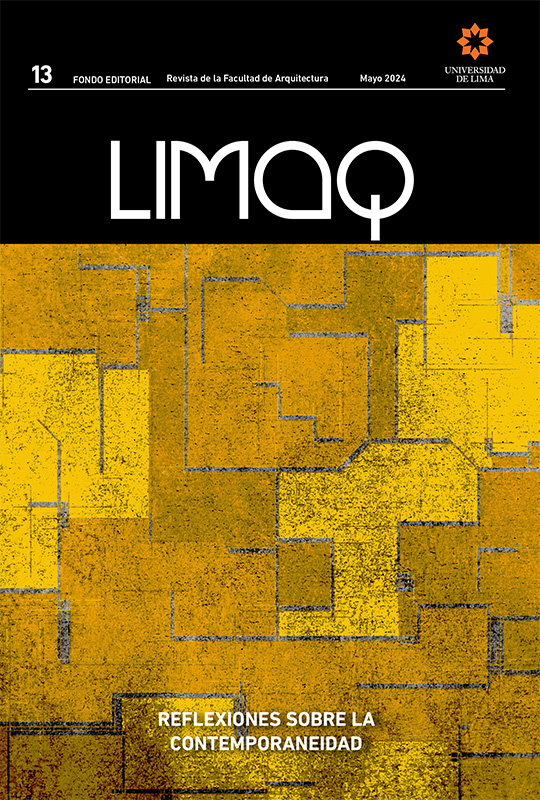Phenomenology and artificial intelligence: a liquid perspective for 21st century architecture
DOI:
https://doi.org/10.26439/limaq2024.n013.6950Keywords:
phenomenological architecture, artificial intelligence, contemporary architecture, interaction with the environment, digital systemsAbstract
Recent advances in Artificial Intelligence (AI) have reshaped our interaction with the world, significantly influencing the architectural industry. This article delves into the role of AI in architectural design, highlighting its capacity to integrate digital and sensory elements in contemporary design. Through a case study and drawing upon Marcos Novak’s Liquid Architecture (1991), the article examines the concepts of virtual reality and three-dimensional immersive landscapes as guidelines for categorizing and analyzing AI’s impact on architecture: that of a technology that heralds new avenues for reasserting subjectivity as a crucial element in accessing the knowledge generated in recent years. This study is a starting point for future research to expand this evolving topic.
Downloads
References
Alda Esparza, F. (2022). Del Mapa Como Objeto Al Posthumanismo Tecnofenomenológico. AusArt, 10(2), 21-35. https://doi.org/10.1387/ausart.23931
Anadol , R. (2022a). Space in the Mind of a Machine: Immersive Narratives. Archit. Design, (92), 28-37. https://doi.org/10.1002/ad.2810
Anadol. R. (2022b). Machine Hallucination – NYC. Refi kanadol. Recuperado el 14 de febrero del 2024 de https://refikanadol.com/works/machine-hallucination-nyc/
As, I., Pal, S., & Basu, P. (2018). Artifi cial intelligence in architecture: Generating conceptual design via deep learning. International Journal of Architectural Computing, 16(4), 306-327. https://doi.org/10.1177/1478077118800982
Carpo, M. (2009). Revolución 2.0. El fi n de la autoría humanista. Arquitectura Viva, (124), 19-25.
Cixin, L. (2008). El problema de los tres cuerpos. Nova.
Del Campo, M., & Leach, N. (2022). Unleashing New Creativities. Archit. Design, 92, 122-135. https://doi.org/10.1002/ad.2823
Estalella, A. (2015). Colectivos de arquitectura: otra sensibilidad urbana. Prototyping. Recuperado el 14 de febrero del 2024 de http://www.prototyping.es/destacado/colectivos-de-arquitectura-otra-sensibilidad-urbana
Estévez, A., & Abdallah, Y. (2022). AI to Matter-Reality. Art, Architecture & Design. iBAG-UIC Barcelona.
Feghali, Y. (2017). Leaky L.A. Yarafeghali. Recuperado el 31 de diciembre de 2023 de https://yarafeghali.com/Leaky-L-A-Author-2018
Feghali, Y. (2018). Leaky L.A. Revista Offramp. SCI-Arc in Los Ángeles. Recuperado el 14 de febrero del 2024 de https://offramp.sciarc.edu/articles/leaky-l.a
Fernández Galiano, L. (1998). Placeres del pliegue. La última vanguardia holandesa. Arquitectura Viva, (69), 42-43.
Fraile-Narváez, M. (2019). Arquitectura Biodigital. Diseño.
Haiman, E. (2021). Endlessskyscraper. Behance. Recuperado el 14 de febrero del 2024 de https://www.behance.net/gallery/132966579/Endlessskyscraper
Haiman, E. (2022). Endlessskyscraper. Archit. Design, (92), 124-125.
Harada, T., Hideyoshi, Y., Gressier-Soudan, E., & Jean, C. (2018). Museum experience design based on multi-sensory transformation approach. International Design Conference, 2221-2228. https://doi.org/10.21278/idc.2018.0150
Holl, S. (1993). Phenomena and Idea. En GA Architect (t. 11, pp. 12-17). A. D. A. Edita.
Husserl, E. (1982). La idea de la fenomenología. Cinco Lecciones. Fondo de Cultura Económica.
Mileto, C. (2006). La conservación de la arquitectura: materia y mensaje sensibles. Loggia. Arquitectura y Restauración, (19), 20-33.
Norberg Schultz, C. (1975). Existencia, Espacio y Arquitectura. Blume.
Novak, M. (1991). Liquid Architectures in Cyberspace. En M. Benedikt (Ed.), Cyberspace: First Steps (pp. 272-285). MIT Press.
Pallasmaa, J. (2012). La mano que piensa. Sabiduría existencial y corporal en la arquitectura. Gustavo Gili.
Presti nenza Puglisi, L. (2009). Anything Goes. Architectural Design, 79(1), 6-12.
Ravenscroft, T. (2022). AI creates “repulsive and strangely compelling” Serpentine Pavilion. Dezeen. Recuperado el 10 de junio del 2022 de https://www.dezeen.com/2022/06/10/ai-designed-serpentine-pavilion/
Teixeira de Almeida, C. C. (2014). O conceito de Metadesign. O Colloquium on Metadesign, na Universidade Goldsmiths em Londres. Sigradi 2014. Design In Freedom, 1(8), 62-66. Recuperado el 14 de febrero del 2024 de www.proceedings.blucher.com.br/evento/sigradi2014
Zátonyi, M. (2002). Una estética del arte y el diseño de imagen y sonido. Nobuko.
Zevi, B. (1981). Saber ver la arquitectura. Ensayo sobre la interpretación espacial de la arquitectura. Poseidón.



